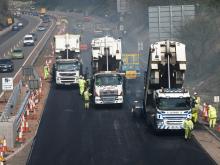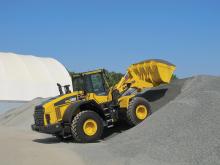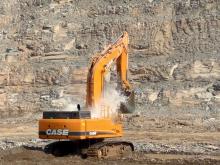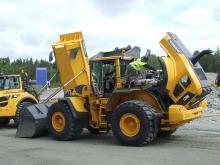Several manufacturers are offering improved earthmoving machines, with more to come - Mike Woof reports. One of the most notable developments comes from Caterpillar, with the unveiling of a hybrid excavator in the shape of its 336E H model. The machine is having its public launch at the bauma exhibition in Spring 2013 and will start rolling out of the factory in March 2013, while customers will be able to place orders from February 2013. Unlike other hybrid excavators on the market at present, the Cat 336E
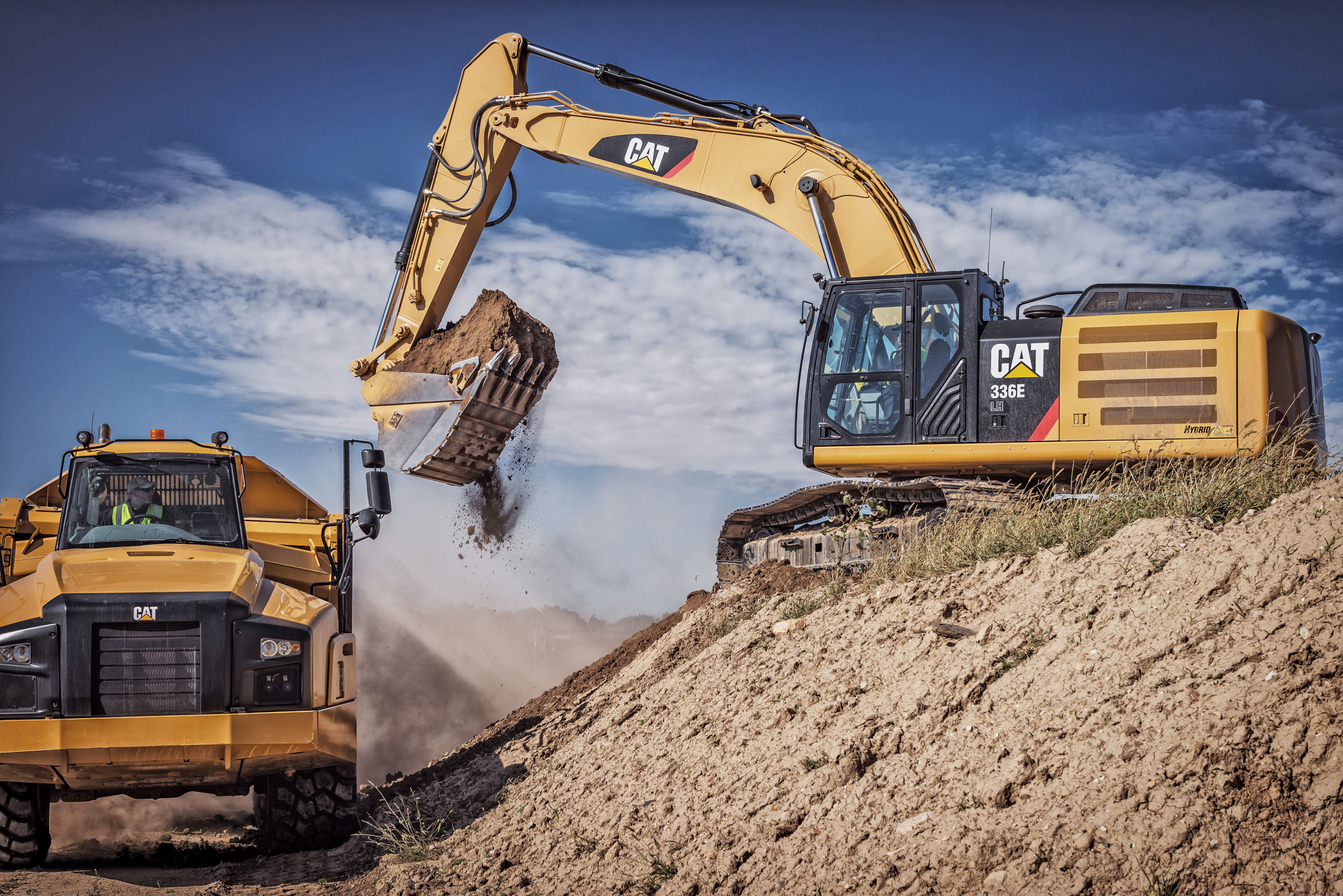
Caterpillar’s new hybrid excavator is said to offer major reduction in emissions and fuel use over the model it replaces
Several manufacturers are offering improved earthmoving machines, with more to come - Mike Woof reports
One of the most notable developments comes fromUnlike other hybrid excavators on the market at present, the Cat 336E H uses a novel hydraulic hybrid system that has been developed by Caterpillar. Although various firms have worked on hybrid machines arch rival
However, Caterpillar’s hybrid excavator represents a radical departure in that it uses hydraulics to conserve and store energy, which means its fuel savings are not limited to intensive truck loading duties. “A hybrid is independent of any particular technology, it doesn’t have to be electric,” explained Ken Gray, global product manager for large hydraulic excavators for Caterpillar’s Excavation Division. “There are many ways to store and reuse energy, including our patented hydraulic hybrid system featured on the Cat 336E H.”
He explained that the firm has tested various systems but opted for this particular concept believing it to be the most versatile and adaptable to different working cycles. Gray said, “Caterpillar has developed, built, and tested electric hybrid excavators but, until now, we had not found a hybrid approach that would actually lower our customers’ owning and operating costs. Large excavators operate in high-production applications in which fuel is a very significant operating cost for our customers. So, the 336E H, the hybrid version of our workhorse 336E, is ideal for introducing our new hydraulic hybrid technology, with more than 300 filed patents.”
Stored hydraulic power has been used in machines for some time and Caterpillar has offered machines that recirculate hydraulic power from boom movements in the past. Re-using hydraulic power is also a concept seen in the hydraulic breaker market by a number of the leading firms. But Caterpillar has taken the concept somewhat further with the highly innovative 336E H excavator. And the firm is making notable claims for this machine’s performance, with fuel savings of around 50% over the earlier 336D model.
According to Caterpillar, The 336E H uses up to 25% less fuel compared to a standard 336E, and up to 33% less fuel than the 330/336D.
This new machine benefits three key concepts that conserve, optimise and reuse power and are integrated together to maximise fuel savings in a variety of duties. Even in low-intensity swing cycles, customers will still benefit from significant fuel savings because of the conserve and optimise technologies.
Gray said, “No other commercially available technology has higher power density than hydraulics, and that’s why we selected a hydraulic solution to help our customers achieve substantial fuel savings. The 336E H
also meets stringent Tier 4 Interim/Stage IIIB emissions standards. It is extraordinarily quiet, too, and they will sacrifice nothing in terms of performance, power, force, speed or production.”
Gary Stampanato, vice president of Caterpillar’s Excavation Division said, “The 336E H is a game-changer. Customers aren’t going to choose the 336E H simply because it is sustainable. They will select it because it actually lowers their owning and operating costs, and maintains the performance of our industry leader, the 336E.”
However, while this machine features hydraulic hybrid technology, Caterpillar is also investing in parallel development of electric hybrid systems. Tana Utley, Caterpillar’s chief technology officer and vice president of the Product Development and Global Technology Division said, “We’re also continuously working on innovations that we anticipate will meet their future needs. That’s why we’re continuing our research and development in electric hybrid technology too, which actually began our hybrid development path several years ago. I am absolutely confident our engineers will continue to discover and develop the best hybrid approaches for Caterpillar’s extensive line of equipment and applications, whether that’s some form of hydraulic or electric hybrid system or something as of yet unknown.”
When the 336E model was introduced in 2010 the main feature was that it met the necessary Tier 4 Interim/Stage IIIB emissions standards for Europe and North America, although it did have some improvements such as an increase in power and fuel efficiency, more lift capability, higher digging force and automatic after-treatment regeneration.
However the 336E H has taken a step further with regard to fuel efficiency, which has been achieved through the integration of three building block technologies. One of these is the Cat electronic standardised programmable (ESP) pump, which transitions between the hydraulic hybrid power sources, engine and accumulator. Another system optimises performance using the patented Cat adaptive control system (ACS) valve, which manages restrictions and flows to control machine motion with no loss of power. The third system reuses energy using the hydraulic hybrid swing system, which captures the excavator’s upper structure swing brake energy in accumulators, and then releases this during swing acceleration.
As the 336E H burns less fuel and reduces regulated engine emissions, both operating costs and CO2 emissions will be cut compared to standard machines. The company claims that with current fuel prices, customers in some markets will see a return on investment for this hybrid within just 12 months. As with other machines, the excavator is designed to be durable and reliable, while its components can be replaced or rebuilt to maximise service life and further increase the whole life cost benefits.
Field-follow machines have notched up thousands of working hours to prove the technology, as well as to show the durability and reliability of the various systems. In addition, the ACS and hybrid system have also proven to work well together to maximise performance and controllability of work tools, including hammers, shears and grapples.
This regenerative hydraulic technology will also be used in other Caterpillar machines in the future. Utley added, “Caterpillar will include hybrid elements in machines where it is evident those elements are the most efficient and effective means of improving value to our customers, which is what we’ve done with the 336E H.”
Also from Caterpillar comes the 966K XE wheeled loader, which features an advanced powertrain and is said to offer fuel savings of up to 25%. A key feature is its integrated continuously variable transmission system. A hydraulic pump and motor (variator unit), allows for a smooth and continuous gear ratio change between engine speed and machine speed. The variator provides this ratio flexibility while reducing the heat load generated by the drive train when the machine is digging, pushing and climbing under load. The continuously variable gear ratio of the variator allows the engine to run at a more efficient operating range independent of machine ground speed. The 966K XE is powered by a Cat C9.3 diesel, delivering 220kW and meeting the Tier 4 Interim/Stage IIIB emissions standards.
When entering the muckpile the drivetrain allows the machine to reduce speed without the operator needing to downshift and as the ratio changes are seamless the system also reduces tyre wear.
Earthmoving machine developments are not restricted to excavators and wheeled loaders and in the field of compaction,
Other advantages include better operator comfort, reduced noise and better fuel economy. These machines deliver static linear loads ranging from 25-45kg/cm, while the CA3500 and CA400 generate amplitudes of 1.8-2mm. Customers can also use the Dynapac software to further optimise operations through better planning, performance monitoring and analysis of results, and the CostCtrl software can be accessed on the Internet.
From
To increase stability the operating weight of the DX380LC-3 excavator has been increased by 3.5% to 39.2tonnes and the size of counterweight has been increased by 300kg to 7.4tonnes.
A new travel device in the DX380LC-3 has increased drawbar pull by 15% to 36.9tonnes and produced a 15% increase in swing torque. Improved hydraulic pumps and valves increase main pump flow capacity by 23% and pilot flow has been increased by 11%.
Overall, the hydraulic system of the new generation DX380LC-3 excavator improves performance and productivity, with highly responsive joystick controls that give the operator what they expect.
The DL300-3 wheeled loader is powered by the 9litre
Weighing in at around 18.6tonnes depending on specification, this is the smallest of Doosan’s new large wheeled loaders and is said to combine high engine power output with a new ZF transmission to minimise fuel consumption. The SCR technology reduces fuel consumption by about 10% compared to similar size machines using EGR technology.
With a bucket capacity of 3m3, the new DL300-3 wheeled loader is designed to meet a wide range of demands and suits loading and transporting material such as sand and gravel as well as quarrying applications.
In Europe, Komatsu is now offering the improved D155AX-7 crawler dozer, which is powered by a fuel efficient 15.24litre diesel that meets Stage IIIB emissions requirements. The Komatsu SAA6D140E-6 engine delivers 264kW and is said to offer high torque response while reducing fuel consumption. Weighing in at 39.5tonnes depending on machine configuration, the new dozer model has been developed as a multi-purpose machine that can handle applications from heavy duty dozing to fine grading. It features the firm’s proven Sigmadozer blade, as well as an efficient automatic transmission with torque converter lock-up.
Earthmoving and grading performance and efficiency for the new D155AX-7 can be further improved through the use of an optional
Also new from Komatsu is the WA380-7 wheeled loader, which weighs in at 17.9tonnes and is said to offer improved efficiency, lower fuel consumption, increased operator comfort, and better serviceability. The firm claims that the new model can maximise productivity while reducing operating costs. Power for the WA380-7 comes from a Komatsu SAA6D107E-2 diesel delivering 143kW and which is Stage IIIB/Tier 4 Interim emissions compliant. Improved hydraulics and driveline combine with the new engine to reduce fuel consumption by up to 10% over the WA380-6 model being replaced. The new WA380-7 also benefits from the Komatsu CARE maintenance programme that comes as standard with every new Komatsu Stage IIIB compliant machine. This lasts for the first three years or 2,000 hours and Komatsu CARE offers up to a maximum of two complimentary Komatsu Diesel Particulate Filter (KDPF) exchanges and a KDPF warranty for the first five years or 9,000 hours.
The WA380-7 also features the Komatsu SmartLoader Logic, which optimises engine torque for the job required and helps save fuel by automatically lowering engine torque when the machine is not working hard. In addition, the WA380-7 has a newly designed Komatsu torque converter with lock-up as standard, which improves acceleration and gradient capability, increase top speed and reduces fuel consumption. The function activates in 2nd, 3rd and 4th gears and gives the machine a maximum ground speed of 40km/h.

